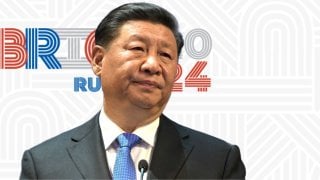The Diminishing Prospects for U.S.-China Détente
The most likely outcome is that Washington and Beijing, driven by false assumptions, will continue the cycle of interactive steps that risk escalating bilateral tensions.
The pursuit of peaceful coexistence will also require accepting that U.S. global primacy is a thing of the past. In the CSIS report, Brands presumes that Washington’s goal is “a world order in which the United States, its allies and partners, and its democratic values remain predominant.” But Shirk says that the idea of “complete primacy is an outdated holdover from an exceptional period of U.S. unipolarity” at the end of the Cold War and that emphasizing it now “smacks of a playground fight, not a principled aspiration for peace and order.” And scholar Melanie Sisson asserts that a U.S. “strategy that tries to recapture the primacy of the past century, rather than to position the United States to succeed as a great power in the next one, will most likely fail to do either.”
The bottom line, as noted above, is that peaceful coexistence between the United States and China is imperative, and the inconvenient truth is that it will require a combination of mutual accommodation, strategic empathy, and intense bilateral diplomacy. The alternative is an escalating cold war based on false premises and faulty assumptions on both sides. The United States and China must be prepared for the process of working out the terms of coexistence within a multipolar world rather than using inaccurate characterizations or assessments of each other’s strategic intentions as an excuse for avoiding that process. Neither side can pretend or afford to believe that it has the leverage to get everything it wants. Both need to explore where U.S. and Chinese interests really are mutually exclusive or irreconcilable. It is worth noting that most of the rest of the world wants Washington and Beijing to do this.
This would be a prolonged and difficult process. However, another recent Washington think tank report suggests ways to approach it: “U.S.-China Relations for the 2030s: Toward a Realistic Scenario for Coexistence,” from the Carnegie Endowment for International Peace. In this report, Medeiros (who also contributed to the CSIS report) highlights the need to forge “a relationship in which competition and confrontation do not prevail at every moment and in every context.” Former senior intelligence officer John Culver suggests that Washington and Beijing need to “create complementary narratives that emphasize they have more to gain than lose” by constraining their competition and recognizing that “a less confrontational approach is possible…”
Scholar Stephen Wertheim invokes other strategists who have proposed a “competitive coexistence” in which the U.S.-China relationship “had achieved or was at least moving toward détente, marked by stable, predictable patterns of interaction and mutual respect for [each other’s] vital interests.” He adds that Washington “would have to accept that it harbored unrealistic expectations [about Chinese liberalization and acquiescence to U.S. primacy] that exceeded the requirements of U.S. national security” and that doing so would “create the political space to accept coexistence with Beijing on terms that support U.S. interests [even if they] are less favorable than in prior decades.” In short, competitive coexistence would require the United States to “meet China halfway.”
Many observers will reject all of this as unnecessary and dangerous concessions to China. Indeed, the editor of the Carnegie report, Christopher Chivvis, acknowledges that the policy shifts this scenario would require from both Washington and Beijing “might never materialize” because of the lack of bilateral trust and because—for example—“China might be unwilling to make credible commitments to global restraint.” At the same time, “the United States might be unwilling to accept any global role for China whatsoever.”
Other major obstacles will hinder any pursuit of a competitive, peaceful coexistence. Many strategists will continue to reject the judgments that Chinese ambitions are limited, that compromise with Beijing is necessary or possible, and that U.S. primacy is no longer sustainable. In particular, the belief that China poses a zero-sum existential threat to the United States that excludes the potential for accommodation appears impervious to empirical argument. This may be due in part to inflated U.S. threat perceptions based on self-inflicted political and economic vulnerabilities. Perhaps most importantly, given this mindset and the domestic political equation, advocating an accommodative or cooperative approach to China does not appear to be politically viable for the foreseeable future.
As a result, promoting diplomatic engagement aimed at peaceful coexistence with China will probably remain an isolated view that generates little support or credibility. Instead, Washington and Beijing, driven by false assumptions, will probably continue the cycle of interactive steps that risk escalating bilateral tensions. As summarized by the editor of the CSIS report, Jude Blanchette, this “mutual mistrust and strategic rivalry” is preventing the two sides from dealing with the “shared responsibility to steward a livable future for all, leaving the world worse off.” That appears to be the path we are on.
Paul Heer is a Non-Resident Senior Fellow at the Chicago Council on Global Affairs. He served as National Intelligence Officer for East Asia from 2007 to 2015. He is the author of Mr. X and the Pacific: George F. Kennan and American Policy in East Asia (Cornell University Press, 2018).
Image: Atlas Aura / Shutterstock.com.

